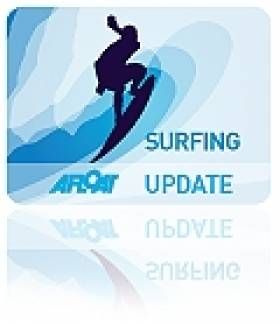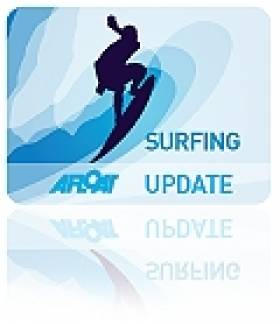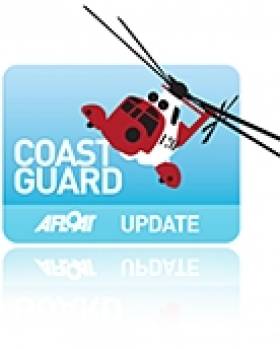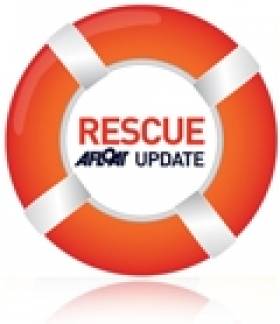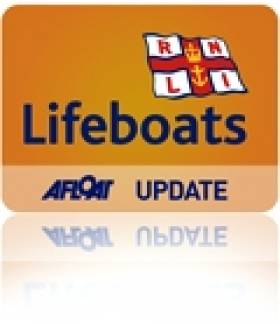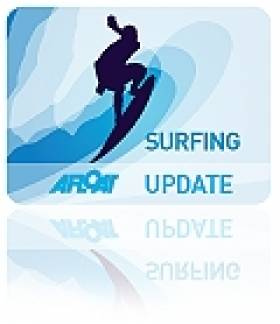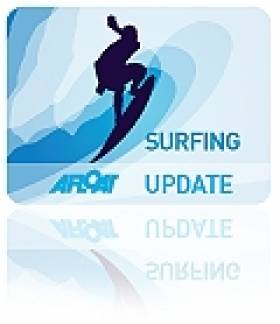Displaying items by tag: Surf
Yacht Capsizes in Surf at Spanish Port of Zumaia
#capsize – A Bavaria 38 yacht, with seven crew on board, enters the narrow channel leading to the port of Zumaia on the Basque coast of Spain this month with dramatic consequences. 'The swell is of medium size, the operation is dangerous, but passable' according to local photographer Gabi Aymat who shot this dramatic capsize video.
A huge wave sweeps on to the boat and rolls it over knocking some of its untethered crew over board. The good news is that the crew survived and the boat is also safe, surviving its roll without any serious damage, according to Aymat.
Spectacular Surf Video Shows Portugal's Monster Wave
#surf – Here's spectacular footage of those enormous waves surfed in Nazare, Portugal by Irish American surfer Garrett McNamara. Check out the slow motion wipe out at 1:58 on the timeline. Awesome!
The video is produced by Othmane Choufani, Jérôme Sahyoun and Axi Muniain during the historic tow-in session of January 28th, 2013.
Bundoran RNLI Lifeboat Crew Welcome Surf Champion Bethany Hamilton
Bethany lost her left arm in a shark attack off the North Shore of Kauai in Hawaii in 2003. The incident and her recovery are the subject of the new Disney film 'Soul Surfer'. Following the attack, Bethany overcame all the odds to become a champion surfer again. The film features an all star cast including Anna Sophia Robb, Helen Hunt and Dennis Quaid.
Bethany called in to say hello to the lifeboat crew and was happy to pose for a photograph with the volunteers. She is also no stranger to the area, having traced her family roots back to the Donegal town through the Hamilton's of Hamilton Hall. The lifeboat crew made sure she was made very welcome and presented her with her very own RNLI "SOS" t-shirt and pen.
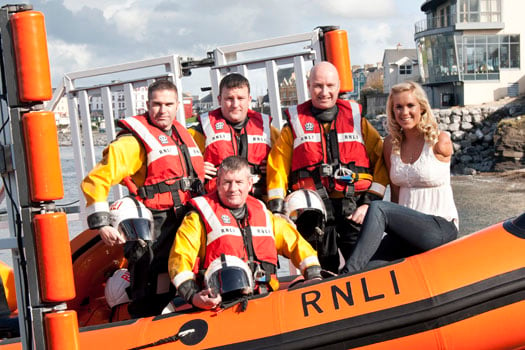
Surfer Bethany Hamilton with RNLI Bundoran. Photo: Linda McNulty
Speaking during the visit Bethany said, "With the incredible amount of time that I've spent in the ocean I've learnt how important emergency services are. The work that the RNLI Lifeboat guys do here in Bundoran is amazing and to do it on a voluntary basis really blows my mind - what a blessing for the community. The commitment these guys show, is second to none."
Commenting on the visit Colm Hamrogue, Bundoran RNLI lifeboat press officer added, "We were thrilled to welcome Bethany to the lifeboat station and show her the lifeboat. It was an honour to meet the person who has overcome such adversity to go on and become a champion in her sport. She is a true inspiration to the RNLI volunteers who go out and save lives at sea."
{youtube}MWeOjBCi3c4{/youtube}
The European Surfing Championships are being held in Bundoran for the third time in the competition's history and run from September 23rd to the 2nd of October. As always the Bundoran RNLI volunteer lifeboat crew will be available if needed and wish all the competitors the very best of luck.
Kitesurfer Rescued off Liverpool
Liverpool Coastguard was contacted by Wirral Lifeguards who had been watching a kite surfer who had returned to sea to retrieve his lost kite in strong winds and a choppy sea. The kite which he was using was seen to come down in the sea. Lifeguards used a jet ski to look for the kite surfer but on arrival at the scene could only find two kites and no kite surfer.
Liverpool Coastguard requested the attendance of RNLI New Brighton inshore lifeboat and a rescue helicopter from RAF Valley and a search began for the kite surfer.
The kite surfer was located by the lifeboat about a mile offshore and recovered to shore.
Liverpool Coastguard Watch Manager Paul Parkes says,
"The kite surfer was lucky to be found because it is hard to spot a head in a black wet suit in choppy water like today. The combination of strong offshore winds and an outgoing tide created difficult conditions for making back to shore. Fortunately he was able to lift his board up out of the water when he heard the lifeboat engines in his vicinity.
Coastguard warns water sports enthusiasts to always check conditions and tides before setting off. Don't go alone and always wear a personal flotation device, (PFD). Wear bright clothing which will help you be located if you get into difficulty."
Lifeguarding in Ireland
It might be hard to believe it but there is plenty of work here in Ireland for the professional lifeguard, from working in a leisure centre swimming pool, to the beautiful beaches around the coast and a beach lifeguard is needed to attain a surf coach qualification according to Muirtí Ó Cearnaigh of Atlantic Coast Lifeguards.
There are slight variations in the qualifications and experience needed to work in both these industries. A lot of people think a lifeguard is a person who is there to save lifes in the event of an accident happening but in actual fact they are there to prevent the incident happening in the first instance. With this they learn about every hazard and risk that is in their particular enviroment and the prevention methods needed to provide safety to the public.
They also learn techniques needed in the event of of actually preforming a rescue, which will include the use of communication with public and casualty, working in a team enviroment, rescue equipment, how to work well with other emergency services, life support, first aid and also train hard in terms of personal fitness.
When you are deciding whether to become a pool lifeguard or beach lifeguard, it really depends on your personal swimming abilty, a pool is a closed enviroment so there is minimum swimming required, where as the beach is a open enviroment so a strong fitness level in swimming is required.
There are two organisations in Ireland in which you can turn to to aquire the certification needed to work in either industry. Institute of Qualified Lifeguards Ireland (Lifeguards Ireland) which receive certification form Royal lifesaving soceity which is endoresed by the international lifesaving federation. And Irish Water Safety which have a very strong youth training programme set out in most counties.
When looking for certification look for out the (NPLQ) National Pool Lifeguard Qualification or (NBLQ) National Beach Lifeguard Qualification, you can find full information on both of these on www.atlanticcoastlifeguards.com where you can also find up and coming courses and any pre requisits needed for each.
Also check out www.lifeguardsireland.com & www.iws.ie for information on other lifesaving or lifeguarding courses nationwide.
Reasons why we think you will want to become a lifeguard:
• First and foremost you are providing an amazing public service. You will without a doubt make people feel confident, happier and safer just by being on the poolside and you could potentially save a life.
• Being a lifeguard offers a fantastic foundation to a career in the leisure industry. Many senior managers began their rise to leisure stardom by lifeguarding at their local pools
• The opportunity to get fit. Not only will you have to have a basic level of fitness to become a lifeguard but you will be encouraged to stay fit and get fitter. Many pools will give their lifeguards discounted or even free memberships.
• You get to work with a team of young like minded people, so there's plenty of opportunity to increase your social circle!
• The hours are flexible and perfect for those of you who need to fit studying into your busy days
• If you're a competitive type there is plenty of opportunity to show off your lifeguarding talents in events like the National Pool Lifeguard Championships (team event) and the Lifeguard Triathlon
• If you find you really enjoy lifeguarding you can take it up as a competitive sport and compete regularly for your local club.
• Lastly but still very importantly, you will gain a life skill that will come in handy for the rest of your life.
Dramatic Photos of Clifden Lifeboat Battling Surf
John organised the training in response to the increased popularity of the area with surfers. RNLI Divisional Assessor Trainer Helena Duggan travelled to the lifeboat station to put 18 volunteer lifeboat crew through their paces and train them in handling the lifeboat in surf and responding to potential callouts from leisure marine enthusiasts.
Training is a core part of volunteering with the RNLI and each crewmember in Clifden trains once a fortnight on the stations two inshore lifeboats.
Commenting on the exercise John said, "I took my camera down to photograph the exercise and was really pleased with the results. It is great to be able to show the public what our lifeboat volunteers go through to ensure they are fit and trained to go to sea. We had a fantastic turnout on the day and the lifeboat crew learned about boat handling in surf conditions. We are delighted so many people are visiting the area for leisure marine activities."
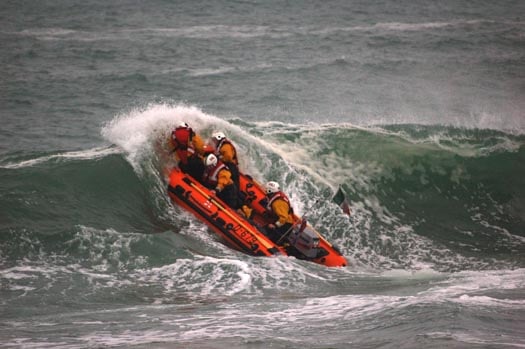
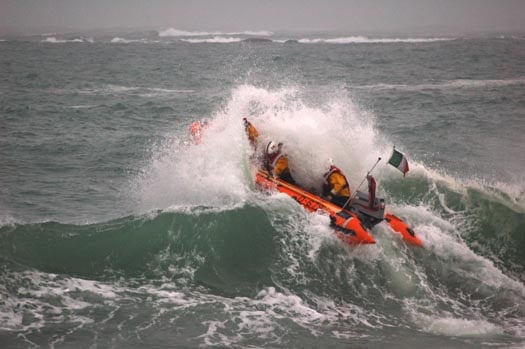
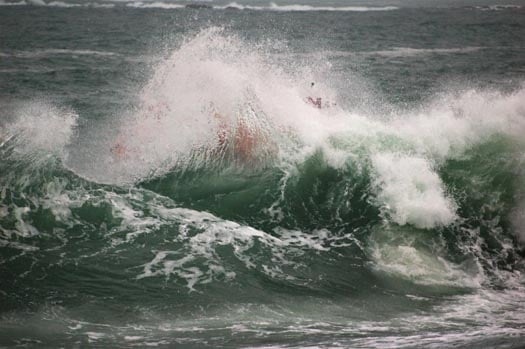
Photos by John Brittain/Clifden RNLI show Clifden volunteer lifeboat crew with RNLI Training assessor Helena Duggan during surf training on Dunloughan beach, Ballyconeely
Related Safety posts
RNLI Lifeboats in Ireland
Safety News
Rescue News from RNLI Lifeboats in Ireland
Coast Guard News from Ireland
Water Safety News from Ireland
Marine Casualty Investigation Board News
Marine Warnings
Cork Surfers Brave More Than The Cold!
There'a always a sliver lining around our coast. Whats a problem for some can be turned to advantage for others. A reef that sailors avoid during racing on coastal courses from Royal Cork presented the perfect setting for some Cork Harbour surfers at the weekend writes Brian Carlin.
A local hazard, the reef is situated approximately a mile west of the entrance to Cork Harbour, dangerous at high tide as most of the reef is immersed. SCROLL DOWN FOR IMAGES.
Surfers took advantage of the direct southerly swell, the surfers, Mark Barry, John Powell and Brian Hartnett, explained only in these conditions is the reef surfable. The trio enjoyed the best of the January sunshine and gave the shoreline spectators a show worth watching. Photos by Brian Carlin.
Giant Prowler Wave Location Remains Secret
According to a Press Association report one of the six-man team, Briton Andrew Cotton, first spotted it several years ago while on board an Irish Coast Guard helicopter after being rescued from a surf accident off Mullaghmore, Co Sligo.
Last night some west coast surfers told Afloat.ie the location is most likely off the Sligo coast, up to two kilometres offshore and close to an underwater reef.
The terrifying-looking wave, dubbed 'Prowlers', was reportedly up to 50ft high on Tuesday when the Irish, British, Australian and South African surfers ventured out. Photos of it appeared on the front page of the Irish Times yesterday.
The surf team included Bundoran's Richie Fitzgerald who says he had waited for five years for the type of conditions required to surf it and on Monday the waves were in the 40-50ft range. Conditions were perfect due to the massive swell generated by Hurricane Tomas.


























